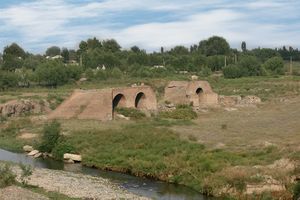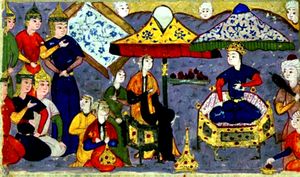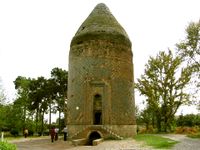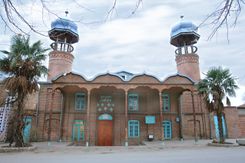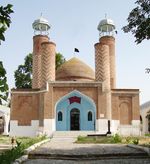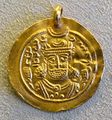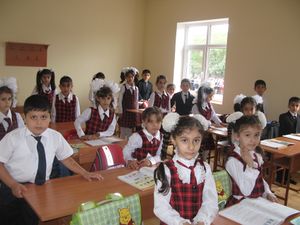برده، أذربيجان
40°22′28″N 47°07′36″E / 40.37444°N 47.12667°E
برده
Barda Bərdə | |
|---|---|
مدينة وبلدية | |
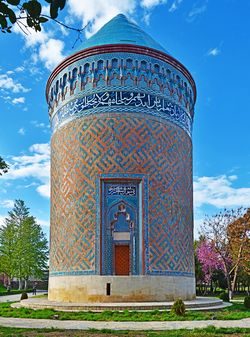 ضريح البرج، برده، أذربيجان. | |
| الإحداثيات: 40°22′28″N 47°07′36″E / 40.37444°N 47.12667°E | |
| البلد | |
| الرايون | برده |
| المنسوب | 76 m (249 ft) |
| التعداد (2010)[1] | |
| • الإجمالي | 41٬277 |
| منطقة التوقيت | UTC+4 (ت.أ.) |
| • الصيف (التوقيت الصيفي) | UTC+5 (ت.أ.) |
| مفتاح الهاتف | +994 2020 |
برده (آذربيجاني: Bərdə (استمع) ؛ إنگليزية: Barda)، هي عاصمة رايون برده في أذربيجان، وتقع جنوب يلڤخ وعلى الضفة الشرقية لنهر ترتار. كانت برده عاصمة ألبانيا القوقازية، منذ نهاية القرن الرابع تقريباً،[2] وأصبحت مدينة رئيسية في مقاطعة أران الإسلامية، ألبانيا القوقازية الكلاسيكية، وظلت كذلك حتى القرن العاشر الميلادي.[3]
أصل الاسم
اسم البلدة، برذعة[بحاجة لمصدر]، مشتق من الكلمة الأرمينية القديمة پارتو Partaw (Պարտաւ)،[4] المشتقة بدورها من الكلمة الإيرانية *pari-tāva- 'rampart'، المكونة من مقطعين، *pari- وتعني 'حول' و*tā̆v- وتعني 'to throw؛ to heap up'.[5]
التاريخ
القديم
في عقد 460، قام ڤاچه الثاني، ملك ألبانيا القوقازية، بأوامر من الامبراطور الساساني پيروز الأول، بتأسيس مستوطنة عُرفت باسم پارتاڤ، والتي أُطلق عليها في البداية اسم پروزاپات، وأصبحت عاصمة لألبانيا القوقازية بدلاً من قبله.[6][7] تبعاً لأطلس القرن السابع، أشار في أنانيا شيراكاتسي في كتاب الجغرافيا Ashkharatsuyts '، أن برده كانت تُعرف باسم پارتاڤ، في أواخر العصر العتيق، وكان تقع في مقاطعة أوتي أراندزناك بمقاطعة أوتيك، والتي كانت تقع في ذلك الوقت على الأراضي الألبانية.[8] (يذكرها المؤلف نفسه أيضاً بين مقاطعات أرمينيا).[7][9] عام 552، أصبحت پارتاڤ المقر الكاثوليكي لكنيسة ألبانيا القوقازية. في منتصف القرن السابع، قاد جوانشير، حاكم گردمان، حملة لطرد المرزپان الفارسي من مقاطعة أوتيك واتخذ من پارتاڤ عاصمة له، وشيد كنائس ومباني أخرى.[7] أرخ لأعماله المؤرخ الأرمني موڤسيس كاگانكاتڤاتسي، الذي ينحدر من قرية مجاورة.
القرون الوسطى
حوالي عام 645، أصبحت پارتاڤ تحت الحكم الإسلامي وأصبحت تُعرف باسم "برده" أو "بردعة" بالعربية. حوالي عام 789، أصبحت العاصمة البديلة الثانية (بعد دڤين) لحاكم (أوستيكان) إمارة أرمينيا.[10] عزز حكامها دفاعات المدينة لمواجهة غزوات الخزر القادمة من الشمال.[3] عام 768، قام كاثوليكوس عموم الأرمن، سيون الأول باڤوناتسي، بعقد مجلساً كنسياً في پارتاڤ، الذي مرر 24 قانوناً تناولت القضايا المتعلقة بإدارة الكنيسة الأرمنية وطقوس الزواج.[7] بحلول القرنين التاسع والعاشر الميلادي، فقدت برده أهميتها الاقتصادية إلى حد كبير، مع صعود بلدة گنجه المجاورة؛ كما نُقل مقر كاثوليكوس كنيسة ألبانيا إلى بردك (بردكور)، لتصبح پارتاڤ مجرد أسقفية.[7][11] وفقاً للجغرافيين المسلمين الإصطخري، ابن حوقل، والمقدسي، استمرت اللغة الألبانية القوقازية كسمة مميزة (والتي أطلقوا عليها اسم "الرانية" أو "الأرانية") في أوائل الحكم الإسلامي لبرده، وكانت مستخدمة هناك في القرن العاشر.[12] Thus, Ibn Hawkal mentioned that the people of Barda spoke Arranian,[13] بينما يقول الإصطخري أن الأرانية كانت لغة "مقاطعة برده".[14]
في ذلك الوقت، كانت المدينة تضم سكاناً من العرب المسلمين، بالإضافة إلى تجمع مسيحي كبير.[3] حتى أن برده كانت في القرن العاشر، مقراً للأسقفية النسطورية.
Referring to events in the late eleventh century, the twelfth-century Armenian historian Matthew of Edessa described Partav as an "Armenian city ["K'aghak'n Hayots'"], which is also called Paytakaran and located near the vast [Caspian] Sea."[15]
The same Muslim geographers describe Barda as a flourishing town with a citadel, a mosque (the treasury of Arran was located here), a circuit wall and gates, and a Sunday bazaar that was called "Keraki," "Korakī" or "al-Kurki" (a name derived from Greek κυριακή (kyriaki), the Lord's Day and Sunday, as the Armenian word kiraki is).[3][16][17] In 914, the city was captured by the Rus, who occupied it for six months. In 943, it was attacked once more by the Rus and sacked.[18] This may have been a factor in the decline of Barḏa in the second half of the tenth century, along with the raids and oppressions from the rulers of the neighboring regions, when the town lost ground to Beylaqan.[3]
Centuries of earthquakes and, finally, the Mongol invasions destroyed much of the town's landmarks, with the exception of the fourteenth century tomb of Ahmad Zocheybana, built by architect Ahmad ibn Ayyub Nakhchivani. The mausoleum is a cylindrical brick tower, decorated with turquoise tiles. There is also the more recently built Imamzadeh Mosque, which has four minarets.[19]
العصر الحديث
Agriculture is the main activity in the area. Local economy is based on the production and processing of cotton, silk, poultry and dairy products. The cease fire line, concluded at the end of the Nagorno-Karabakh War in 1994, is just a few kilometers west of Barda, near Terter.
On 27 October 2020, Armenian missiles struck the city which killed at least 21 civilians, including a 7 year old girl, and injured 70 others.[20][21][22][23][24][25][26]
مشاهير برده
- Khosrow II. Khosrow, the last great king of the Sasanian Empire, is first mentioned in the 580s, when was at Partaw (Barda), the capital of Caucasian Albania. During his stay there, he served as the governor of the kingdom, and managed to put an end to the Kingdom of Iberia and make it into a Sasanian province.[27]
- Mihranids of Caucasian Albania: Javanshir, Varaz-Tiridates I. etc.
- Arabic governors: Muhammad ibn Abi'l-Saj, etc.
- Paykar Khan Igirmi Durt. Qizilbash chieftain in the service of Safavid Persia in the late 16th and early 17th centuries. His career flourished in the southeastern Caucasus, where he ran the governments of Barda and Kakheti on behalf of Shah Abbas I until being overthrown in a Georgian uprising in 1625.
معرض صور
احتفل مسئولو سلاح المهندسين بالجيش الأمريكي، القيادة الأوروپية و السفارة الأمريكية في أذربيجان، في باکو بإكمال إنشاء مدرسة برده الثانوية في أذربيجان مع مسئولي المدينة والمدرسين، في حفل قص الشريط، 14 سبتمبر 2010.
الهامش
- ^ World Gazetteer: Azerbaijan Archived يونيو 22, 2011 at the Wayback Machine – World-Gazetteer.com
- ^ Chaumont, M. L. "Albania." Encyclopaedia Iranica. July 29, 2011.
- ^ أ ب ت ث ج Bosworth, C.E. "Barda'a." Encyclopaedia Iranica. December 15, 1988.
- ^ Pourshariati, Parvaneh. Decline and Fall of the Sasanian Empire: the Sasanian-Parthian Confederacy and the Arab Conquest of Iran. London: I.B. Tauris, 2008, p. 116, note 613.
- ^ (in روسية) Périkhanian, Anahit G. "Этимологические заметки" [Notes on Etymology]. Patma-Banasirakan Handes 1 (1982), 77-80.
- ^ "The earlier capital of Albania seems to have lain north of this river (Kur), whereas the later capital Perozapat (Partav, Barda'a) was built by the Albanian Vach'e only under the Sasanian king Peroz (457-84)": Vladimir Minorsky, A History of Sharvan and Darband in the 10th-11th Centuries. Cambridge: Heffer and Sons, 1958.
- ^ أ ب ت ث ج (in أرمنية) Ulubabyan, Bagrat. «Պարտավ». Armenian Soviet Encyclopedia. Yerevan: Armenian Academy of Sciences, 1983, vol. 9, p. 210.
- ^ Anania Shirakatsi (1992). The Geography of Ananias of Širak: Ašxarhacʻoycʻ, the Long and the Short Recensions. Trans. Robert Hewsen. Wiesbaden: Reichert, p. 66.
- ^ Adontz, Nicholas (1970). Armenia in the Period of Justinian: The Political Conditions Based on the Naxarar System. Trans. and rev. Nina G. Garsoïan. Lisbon: Calouste Gulbenkian Foundation. p. 125*. In the long recension of the Ashkharats'uyts', this section, in Classical Armenian, reads: "Ուտի առ մտից կայ Երասխայ ընդ մէջ Արցախայ և Կուռ գետոյ. ունի գաւառս զոր Աղուանք ունին՝...Ուտի առանձնակ՝ յորում Պարտաւ քաղաք."
- ^ Ter-Ghevondyan, Aram N. (1976). The Arab Emirates in Bagratid Armenia. Trans. Nina G. Garsoïan. Lisbon: Calouste Gulbenkian Foundation. pp. 36–37.
- ^ Kirakos Gandzaketsi. History of the Armenians. Trans. Robert Bedrosian.
- ^ Bosworth, C. E. "Arrān." Encyclopaedia Iranica.
- ^ (in روسية) Арабские источники о населенных пунктах и населении Кавказской Албании и сопредельных областей (Ибн Руста, ал-Мукаддасий, Мас’уди, Ибн Хаукаль)
- ^ (in روسية) Караулов Н. А. Сведения арабских писателей X и XI веков по Р. Хр. о Кавказе, Армении и Адербейджане
- ^ Matthew of Edessa (1993). Armenia and the Crusades: Tenth to Twelfth centuries: The Chronicle of Matthew of Edessa. Trans. Ara E. Dosturian. Lanham: University Press of America, p. 151.
- ^ Wheatley, Paul. The Places Where Men Pray Together: Cities in Islamic lands, Seventh through the Tenth Centuries. Chicago: University of Chicago Press, 2001. ISBN 0-226-89428-2, ISBN 978-0-226-89428-7, p 159.
- ^ Estakhri states that there was a Sunday bazaar in Barda, known locally as "Koraki," which in the opinion of scholar George Bournoutian derives directly from the Armenian, not the Greek, rendition of the word Sunday ("Kiraki"). On this basis, Bournoutian speculates that the city still had a significant Armenian element during the tenth century: see Jamal Javanshir Qarabaghi, Two Chronicles on the History of Karabagh: Mirza Jamal Javanshir’s Tarikh-e Karabagh and Mirza Adigozal Beg’s Karabagh-name. Introduction and annotated translation by George A. Bournoutian. Costa Mesa, CA: Mazda Publishers, 2004, p. 40, note 2.
- ^ Kennedy, Hugh (2004). The Prophet and the Age of the Caliphates: The Islamic Near East from the 6th to the 11th Century, 2nd ed. Harlow: Longman, p. 256.
- ^ Turánszky, Ilona (1979). Azerbaijan, mosques, turrets, palaces. Corvina Kiadó. p. 56. ISBN 978-963-130321-6.
- ^ SABAH, DAILY (2020-10-28). "Armenia's rocket attack on Azerbaijan's Barda kills at least 21 civilians". Daily Sabah (in الإنجليزية). Retrieved 2020-10-28.
- ^ "Armenian attacks kill 21 in Azerbaijan's Barda". aa.com.
{{cite news}}: CS1 maint: url-status (link) - ^ "Azerbaijan says 14 people killed by shelling in Barda: RIA". Reuters (in الإنجليزية الأمريكية).
{{cite web}}: CS1 maint: url-status (link) - ^ APA.az (2020-10-28). "General Prosecutor's Office: Death toll from Armenia's missile attack on Azerbaijan's Barda rises to 21, about 70 people wounded - UPDATED - 2". apa.az (in الأذربيجانية). Retrieved 2020-10-28.
- ^ "Nagorno-Karabakh conflict: Missile strike on Azeri town kills 21 civilians". BBC News (in الإنجليزية البريطانية). 2020-10-28. Retrieved 2020-10-28.
- ^ "Azerbaijan says 21 people got killed in Barda bombing - Updated". Report News Agency (in الإنجليزية). Retrieved 2020-10-28.
- ^ Limited, Bangkok Post Public Company. "Azerbaijan says 21 dead in Armenia missile attack". https://www.bangkokpost.com. Retrieved 2020-10-28.
{{cite web}}: External link in|website= - ^ Howard-Johnston 2010.
للاستزادة
- Barthold, Wilhelm (1987). "Bard̲h̲aʿa". In Houtsma, Martijn Theodoor (ed.). E.J. Brill's first encyclopaedia of Islam, 1913–1936, Volume II: Bābā Fighānī–Dwīn. Leiden: BRILL. p. 656. ISBN 90-04-08265-4.
- Dunlop, D.M. (1960). "Bard̲h̲aʿa". In Gibb, H. A. R.; Kramers, J. H.; Lévi-Provençal, E.; Schacht, J.; Lewis, B.; Pellat, Ch. (eds.). The Encyclopaedia of Islam, New Edition, Volume I: A–B. Leiden: E. J. Brill. pp. 1040–1041. ISBN 90-04-08114-3.
{{cite encyclopedia}}: Invalid|ref=harv(help) - قالب:The Arab Emirates in Bagratid Armenia
- Ulubabyan, Bagrat (1981). Դրվագներ Հայոց արևելից կողմանց պատմության [Episodes from the History of the Eastern Regions of Armenia] Yerevan: Armenian Academy of Sciences.
- Howard-Johnston, James (2010). "ḴOSROW II". Encyclopaedia Iranica, Online Edition. Retrieved 9 November 2013.
{{cite encyclopedia}}: Invalid|ref=harv(help)
وصلات خارجية
- تحويل قالب:محافظة برده
- Pages using gadget WikiMiniAtlas
- Articles with روسية-language sources (ru)
- Articles with أرمنية-language sources (hy)
- CS1 maint: url-status
- CS1 الإنجليزية الأمريكية-language sources (en-us)
- CS1 الأذربيجانية-language sources (az)
- CS1 الإنجليزية البريطانية-language sources (en-gb)
- Coordinates on Wikidata
- Short description is different from Wikidata
- Articles containing آذربيجاني-language text
- Pages using Lang-xx templates
- Articles containing إنگليزية-language text
- Articles with unsourced statements from November 2016
- أماكن مأهولة في محافظة برده
- ألبانيا القوقازية
- عواصم أمم سابقة
- مدن ساسانية
- محافظة إليزاڤيتپول
- مدن وبلدات في أذربيجان

